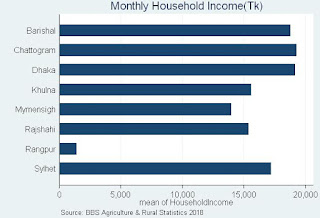Swelling of major rivers due to incessant rains caused floods in 28 districts. Press reports citing health ministry suggest that flood perished 114 lives and made hundreds of thousands of people homeless between Jul10 and July 26. Initial damage is still being assessed. Government has definitely plans to come up with relief efforts to tackle with post flood challenges.
Challenges span from creating jobs/cash benefits till the next harvest period to provide agricultural credit to farmers affected by flood. This is no easy task and Bangladesh did this kind of job quite well in the past. Flood literally affected the whole Bangladesh as the 28 districts scattered through all the divisions including the districts of CHTs. But Barishal, Rangpur, Mymensingh and Rajshahi divisions where agriculture plays a key role in the livelihoods of rural people also sustained damages to crops.
I recently come across “Report on Agricultural and Rural Statistics 2018(RARS 2018)”published by Bangladesh Bureau of Statistics(BBS). According to RARS 2018, agriculture accounts for 53.90 % of annual household income in Rangpur division, only division where agricultural sources dominate over non agricultural sources in determining the annual household income.In Dhaka, non agriculture constitutes 71.19% of annual household income. After Rangpur, agricultural activities are also reported to play a significant role in deciding annual household income in Mymensingh(47.98%), Khulna(46.99%) and Rajshahi (44.88%) divisions. Worst flood-hit districts like Niphamari, Lalmonirhat, Kurigram,Jamalpur, Sherpur and Netrokona lie in Rangpur and Mymensingh divisions. Taking a closer look at the monthly income reveals that monthly household income is lowest in Mymensingh (Tk 14009.83) divison, followed by Rangpur(Tk 14304.42) division. Meanwhile the highest monthly household income is registered in Chattogram(Tk19306.92), followed by Dhaka(Tk 19180.50).It is worthwhile to mention that in the informal sector of Dhaka, a Rickshaw puller and a construction helper draw a monthly salary between Tk 10,170 and Tk 11, 151 throughout the year.
Agricultural activity does not last throughout the year and non agricultural activity does not bring in everyone on board, so there is always the left outs. Wages without food for agricultural labor in all the divisions are pretty high. It somehow buttresses the claim that during the harvesting season even Tk 500/ day does not fetch a worker. However, working days per week are below 5.5 days in the rural areas. Please note that wages without food per day are Tk 360 in Rangpur division, Tk 355 in Rajshahi division and Tk 419 in Mymensigh division. Average working days per week are 4.95 days in Rangpur, 5.01 days in Rajshahi and 4.87 days in Mymensingh. Meanwhile a rickshaw puller gets on average wages of Tk 371 per day in all the working days in Dhaka. Consequently,, income gap and lack of opportunities during the post harvest season lead the rural workers to big cities like Dhaka. It is anticipated that this influx will be more severe in coming months unless well designed post flood relief efforts are taken in flood hit areas particularly in Rangpur and Mymensingh divisions.
Unnayan Onneshan, a not for profit organization, did a field survey among the slum dwellers engaged in informal sector in Agargaon and adjacent areas for a study titled “Accumulation And Alienation: State Of Labor Force in Bangladesh 2013”. In that survey, majority of the respondents (62.7%) said they took up jobs in informal sector due to job crisis in formal sector.
The RARS 2018 tells us that investment cost for transport vehicles and equipment is the highest in Rangpur division. RARS survey also reveals that NGOs appear to be major source of agricultural credit followed by banks. The recent flood without doubt compounded the debt problem of the farmers in the flood hit areas. Affected farmers deserve government’s assistance to attenuate their credit burden through cash benefits or access to interest free credit. The BBS survey highlights that both Aus and Aman crop registered post harvest losses of 8.93% and of 7.70% respectively out of total production in 2018. And the losses are mostly attributed to price volatility in the sales and to reasons associated with processing transportation and storage.
Clearly, pre flood post harvest losses have already pushed the farmers who are now poised to deal with post flood situation to a vulnerable position. Flood damages only augment their worries. In addition BBS rural data shows heavy reliance of rural households on rearing livestock and poultry. The reliance is heavy in flood hit divisions like Rangpur. It is evident that flood will cause significant damage to livestock and poultry. Media report suggests that in many areas cattle and cows are being sold at prices far below than the market prices , causing severe losses to livestock rearing families. Prices of feed and fodder may also go up in the post flood period if proper supply is not ensured.
In the wake of this severe Monsoon calamity, government strategies should focus on two tasks: 1. rejuvenate agricultural activities by providing agricultural credit at concessional rate and agricultural inputs at subsidized cost so that the farmers in flood hit areas can get back to the pre flood situation as soon as possible; 2. initiate programs in collaboration with NGOs to boost non agricultural income generating opportunities in flood hit areas so that rural workforce does not need to worry about lack of job opportunities and rural-urban migration flow does not turn worse.




No comments:
Post a Comment